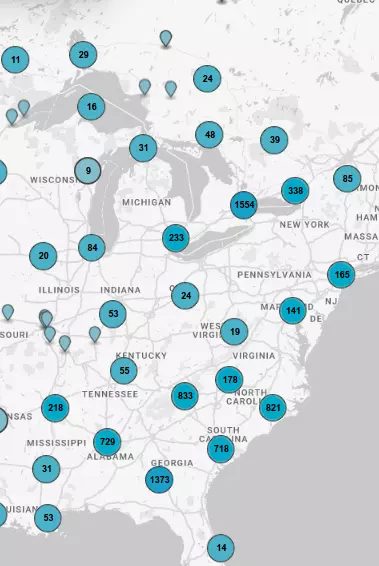The Dale Estate
The Dale Estate nurseries played an instrumental role in the development of Brampton, establishing its reputation as "The Flower Town of Canada." The business began in 1863 with its founder...
- toronto
- ontario
- alan brown
"Dundas Mills"
By 1799 the Morden family had a sawmill near this site on Spencer Creek north of Dundas Street. They sold this property in 1800 to Edward Peer who built a grist-mill about 275 metres...
- toronto
- ontario
- alan brown
Douglas Point Nuclear Power Plant
The Douglas Point Nuclear Power Plant began generating electricity in 1967 and continued until 1984. This joint project between Atomic Energy of Canada Ltd. and Ontario Hydro was the...
- toronto
- ontario
- alan brown
The Disappearing Propeller Boat
Popularly known as the Dispro, or Dippy, this small boat was first built on this site in 1916 by the Disappearing Propeller Boat Company Limited. Also manufactured elsewhere in Ontario and...
- toronto
- ontario
- alan brown
Dundurn Castle 1832
This mansion was built 1832-35 by Allan Napier MacNab (1798-1862) and named after the family ancestral seat in Scotland. Enlisting at fifteen, MacNab distinguished himself by his bravery in...
- toronto
- ontario
- alan brown
District Court House and Jail
In 1838 the District of Colborne was established and Peterborough selected as the "district town". In June of that same year, the district magistrates, with the Hon. Thomas Stewart presiding,...
- toronto
- ontario
- alan brown
The Dalhousie Library
In 1828, eight years after the original settlement of this area, the St. Andrew's Philanthropic Society founded the first public library within the old Bathurst District. A log building, known as...
- toronto
- ontario
- alan brown
Darlingside
Darlingside is a rare surviving example of the wood depots which provided an essential fuelling service during the early phase of steamboat navigation on Lake Ontario and the upper St. Lawrence...
- toronto
- ontario
- alan brown
The Desjardins Canal
In pioneer days waterways provided the essential means of transportation. Dundas, located at the head of navigation on Lake Ontario and the eastern terminus of the "Governor's Road", was thus in...
- toronto
- ontario
- alan brown
Dr. Augusta Stowe Gullen 1857-1943
Canada's first woman graduate in medicine was born in Mount Pleasant. She attended the Toronto School of Medicine, received her degree from Victoria University in 1883, and was licensed to...
- toronto
- ontario
- alan brown
Duncombe's Uprising 1837
Dr. Charles Duncombe (1791-1867), prominent physician and politician, was leader of the militant reform movement in the London District at the time of the Rebellion of 1837. He rallied the local...
- toronto
- ontario
- alan brown
David Boyle 1842-1911
Born in Scotland, Boyle came to Canada in 1856 and settled in this area. As a local school teacher, he began an extensive collection of native artifacts and became an archaeological...
- toronto
- ontario
- alan brown
Donald Allerton Johnston 1874-1957
Born on a nearby farm, Johnston became a co- founder and, in 1915, the first president of the world's first Kiwanis Club. He spent his childhood in this area, and in 1892 emigrated to...
- toronto
- ontario
- alan brown
Dufferin County Court House
Construction of this imposing brick court house was begun in the spring of 1880. Designed by C.J. Soule, a Guelph architect, it was built by the contracting firm of Dobbie and Grierson....
- toronto
- ontario
- alan brown
Dundas Street
Dundas Street, named for Henry Dundas, Secretary of State for the British Home Department (1791-1794), was built on Lieutenant Governor Simcoe's orders in 1793-1794. The road, cut by a party of...
- toronto
- ontario
- alan brown
The Dutch Settlement of Holland Marsh
The Holland Marsh consists of 2832 ha of reclaimed land in a river valley north of Toronto, Ontario. Named after an early provincial official, this fertile area was drained between 1925 and...
- toronto
- ontario
- alan brown
Dr. Robert Hamilton Coats 1874-1960
Born near here, Coats was educated locally and graduated in 1896 from the University of Toronto. In 1902 Mackenzie King, then Deputy Minister of Labour, persuaded Coats to become editor of...
- toronto
- ontario
- alan brown
David Allanson Jones 1836-1910
World renowned breeder of bees and pioneer of the North American beekeeping industry, he came in 1867 to Clarksville which, in 1874, was renamed Beetown (now Beeton). Jones searched the Old...
- toronto
- ontario
- alan brown
Daniel Knechtel 1843-1936
Born in Waterloo County, Daniel Knechtel came to Hanover in 1864. Two years later, he began producing handcrafted furniture and in 1874 opened a factory on this site. By using local...
- toronto
- ontario
- alan brown
The Dutch Settlement of Holland Marsh
The Holland Marsh consists of 2832 ha of reclaimed land in the Schomberg River Valley. Named after an early provincial official, this fertile area was drained between 1925 and 1930. John Snor,...
- toronto
- ontario
- alan brown
